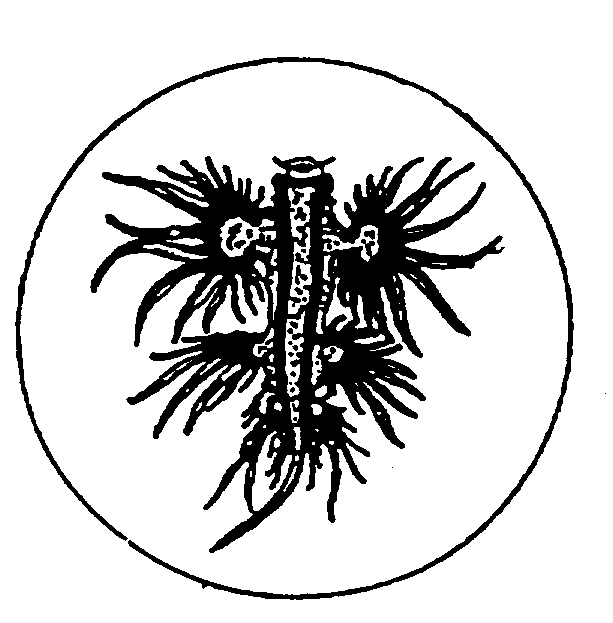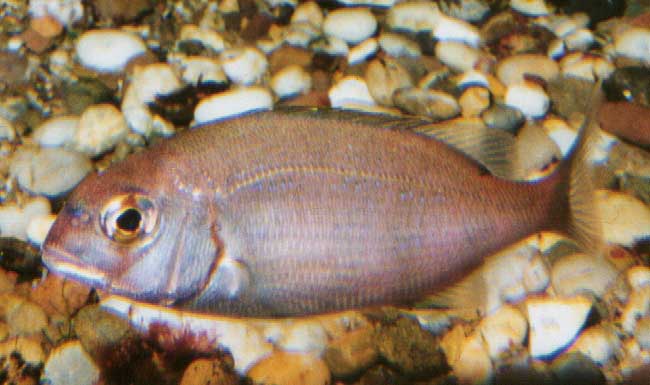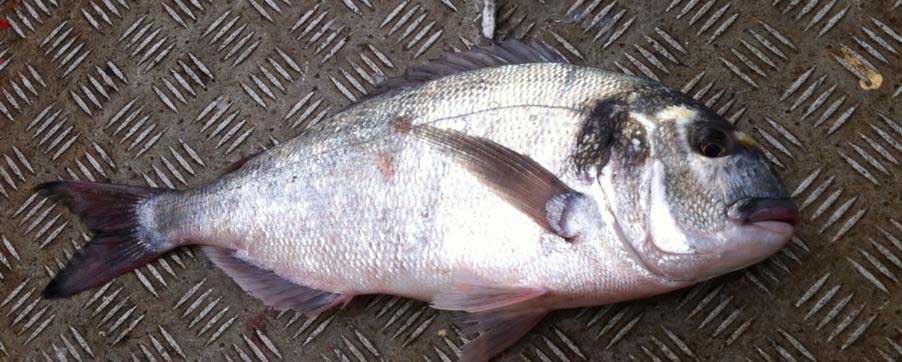
|
|
| Porifera |
| Ctenophora |
| Cnidaria |
| Mollusca |
| Echinodermata |
| Annelida |
| Arthropoda |
| Other Phyla |
| Chordata |
|
|
Sea-Breams
| Common
Name(s):
Sea-Bream Family Name: Sparidae Family: Usual Size:
|
Identification:
The Black Sea Bream is rather variable in appearance, though the deep body with long dorsal and anal fins is characteristic, some individuals are much deeper-bodied than others. Young fish have silvery flanks with many pale broken lines along them and a wide dark band on the tail; adults may be silvery or dark blue-grey, almost black in mating males, and may have alternating dark and silver vertical stripes on their sides. Adults are usually 35 - 40 cm long, occasionally more. They are omnivorous, feeding on small fish and crustaceans, small encrusting animals and algae, and are usually seen and caught around rocky areas and wrecks. ------------------------------------------------------------------------------------------ Compare with an unidentified Bream, possibly Pagrus pagrus.
Ray Fallaize caught a record Couch's Sea-Bream, Pagrus pagrus, on rod and line from a boat in Guernsey waters. His capture has been accepted by the British Record Angling Committee. It weighed 6 lb 9 oz 7 drams (3 kg). Its total length was 560 mm and fork length was 495 mm. Report
and Photograph by Richard
Lord (Guernsey)
Full
Report
British Sea Angling Records Sealord Photography BMLSS Couch's Bream ------------------------------------------------------------------------------------------ Fishbase
entry (Link)
6 September 2006 An unidentified juvenile (120 mm) sea bream was caught in the River Tamar and returned alive. The yellow horizontal broken stripes are rather distinctive. The position of the eyes in relation to the mouth rather indicates the Black Sea-Bream, Spondyliosoma cantharus, but there are other species of vagrant bream from southern seas which it could possibly be. Report
by David Fenwick (Snr)
Breeding:
Black Sea-Bream, Spondyliosoma cantharus, breed regularly at the eastern end of the English Channel; this is probably their northern limit for breeding, although they are found as summer migrants around much of Britain. The male excavates a depression in a sandy seabed, and the female lays her eggs into it. The eggs stick to the base of the nest, where they are fertilised and guarded fiercely by the male until they hatch. The young fish remain in the area of the nest for several weeks before dispersing. The
Black
Sea Bream,
Spondyliosoma
cantharus, is a protogynous hermaphrodite
- female first and then becoming a male at a length of over 20 cm (I think,
from memory). The White Sea Bream,
Diplodus
sargus, is a protandrous hermaphrodite,
starting life as a male and becoming a female later in life. White
Sea Bream are found in the seas around
the Channel Islands in the English Channel.
Comment
by Richard Lord (Guernsey)
Habitat:
Food: Range: Additional Notes: A
young Black Sea-Bream
Black Bream are popular with anglers, but not usually abundant enough to be fished commercially. They are also known as Old Wife. I have seen plenty
of small Black Sea Bream when diving out of both Littlehampton and Bognor
in Sussex with sizes varying from 3 - 4 cm long up to 13 cm, but never
larger. Smaller ones, up to about 10 cm, were always in loose shoals with
up to 7 individuals seen at one time, but may have been part of a larger
shoal. They were usually to be found over a mixed cobble, pebble and gravel
seabed.
Notes: Black Bream have returned to the seas around Mevagissey in south Cornwall this year, with four specimens caught by an angler off the Lighthouse Quay at Mevagissey and displayed in the Aquarium (05.01.06) on the quay in the harbour. Report
by Chris Gilbertson
When swimming the fish is usually
a silvery colour, but when resting at night or when caught on a hook, the
fish displays black vertical barring. However, specimens seen at Anglesey
Sea Zoo caught in the seas around north Wales were black.
10
July 2005
Report
by Jim Crighton
11 January 2002 Witek Mojsiewicz reports the capture of a Black Sea-Bream, Spondyliosoma cantharus, caught by MFV 'Charisma' 18 miles NW of Macduff in the Moray Firth, NE Scotland. The fish was 365 mm long and weighed 940 grams. The sea temperature was 6° C. This fish is rare this far north. Off the Sussex coast this is a common fish that supports a small fishery and the winter sea temperature only falls to 7° C. Received
28 May 2003
Angling Records: (out of date)
National
Federation of Sea Anglers
Gilthead
Bream Sparus
aurata
In 1967 I sent an unfamiliar fish to Alwyne Wheeler for identification. It had been caught in a trawl off Worthing, West Sussex, after strong southerly gales in late October. Alwyne Wheeler identified the fish as a Gilthead Bream. It weighed 1.13 kg. Since then, two more specimens have been recorded, one in November 1968, from a trammel net off Littlehampton, and the other was noticed in the Brighton fish market in 1971. It was caught by a local boat. This
fish is a southerly species caught occasionally off the Cornish and Devon
coasts, but rarely caught east of the Isle of Wight.
c.
20 September 2001
Reports
by Nicolas Jouault
and Richard Lord
8 October 2001 A Pandora Bream, Pagellus erythrinus, was caught by angler Phillip Jewell in the River Helford estuary, Cornwall. This is one of the rarer summer visitor sea breams (Family: Sparidae) to the English Channel. This was a new British angling record and the fish weighed in at 692 grams. ------------------------------------------------------------------------------------------ Saupe or Salema, Sarpa salpa 30
April 2009
----------------------------------------------------------------------------------------------------- c. 20 September 2001 There have been several reports of unusual Sea Breams (family: Sparidae) from around the Channel Islands. Shore angler Kevin Frain caught a Gilthead Bream, Sparus aurata, and there was a report of a White Sea Bream, Diplodus sargus, from St. Helier Marina, Jersey. Neither of these catches have been verified by an expert or confirmed by a photograph but they are likely to be accurate. Reports
by Nicolas Jouault
and Richard Lord
------------------------------------------------------------------------------------------
28
January 2008
Report
and Photograph by Richard
Lord (Guernsey)
Sealord
Photography
---------------------------------------------------------------------
13
January 2014
Fisherman Mike Ould (on FV Bronco TH74) landed a 39 cm long silvery sea bream (Sparidae) called a Bogue, Boops boops, fishing inshore off Babbacombe, south Devon, on the east facing coast. This Mediterranean fish is a scarce discovery off the British coast but there does seem to be a population in Babbacombe Bay and shallow seas around Devon and Cornwall as well as around the Channel Islands. The fish appears in small schools so where there is one, there are most likely more of them. Report
& Photographs by Rachel Irish (Marine
Management Organisation MMO at Brixham)
Report
and Image on Sealife
Survey facebook
2 August
2009
A Bogue, Boops boops, was caught in a Red Mullet net in 10 metres of water about half a mile off the shore at Seaton, south east Cornwall, by Chris Dominic on the FV Emma May. This
fish was about 17 cm (6 - 7"), but they can grow to 38 cm (14").
They are a shoaling fish and are a commercial species in southern Europe.
They are classified in the Sparidae Sea Bream family and I assume they
are good eating. They are rare in British waters and most have been
caught in the Channel Islands, but they have also been found in Torbay
and several other places. They are regularly caught in Red Mullet nets
in Mount's Bay Cornwall in the autumn, but this is the first I had heard
of from Whitsand Bay.
Report
and Comments by Doug Herdson
(Fish Information Services)
on the Marine Wildlife of the NE Atlantic Ocean (Yahoo Group)
Bogue belong to the family Sparidae (Sea Breams). They are common Mediterranean fish, but uncommon in Guernsey waters where a few are caught every year. All the Guernsey records I have for this fish come from the L'Ancresse area (north of Guernsey). To give a sense of this fish's rarity Steve Fallaize has never seen this fish before and he has been fishing commercially in Guernsey waters since 1986. Sealord Photography Two-banded Sea Bream, Diplodus vulgaris 19
July 2009
I visited the area and saw silvery fish but was not able to identify them. On Sunday 19 July 2009 he called me from a similar location to tell me the small silvery fish were back. While sitting by him he caught the first positively identified white sea bream, Diplodus sargus, from Guernsey waters. They have been confirmed in Jersey waters for a while. The fish Andy caught was 14.8 cm in total length and weighed 68 grams. Dave Foxen produced a video of what appears to be white sea bream swimming in Grand Havre bay on Guernsey's north-west coast on 21 October 2007. The video can be seen here: http://www.splashvision.com/Video/9341_White-Bream.html Other recreational anglers have caught small fish in Guernsey waters resembling white bream but they have not been positively identified. Andy Marquis' white sea bream at 2 oz and 5 drams is now a Guernsey angling record for this species. The Jersey record currently stands at 1 lb. 10 oz. Owing to the small size of the Guernsey fish they may be breeding in Channel Islands waters. This is the second species of bream (family sparidae) this year to have been identified and added to the list of fishes caught in Guernsey waters. 29 January 2009Commercial fisherman Steve Fallaize caught a Two-banded Sea Bream, Diplodus vulgaris, in a gill net set over night one mile off L'Ancresse off the north coast of Guernsey. It weighed 1011 grams.
This fish is a new record for the British Isles. It is principally a Mediterranean species and is also found on the Atlantic Seaboard of continental Europe and North Africa including Brittany where it is rare.
Bramidae: family of Pomfrets Information wanted: Please
send any records of this fish, with location, date, who discovered it,
how it was identified, prevalence, common name and any other details to
All messages will receive
a reply.
|
|||||||||||||||||||||||||||||||||||||||||||||||||||||||||||||||||||||||||||||||||||||||||||||||||||||||||||||||||||||||||||||||||||||||||||||||||||||||||||||||||||||||||||||||||||||||||||
| FIVE KINGDOMS TAXONOMIC INDEX TO BRITISH MARINE WILDLIFE |
Copyright 2000 - 2009 British Marine Life Study Society
|
|
|
News 2018 |
Membership Form |
|












